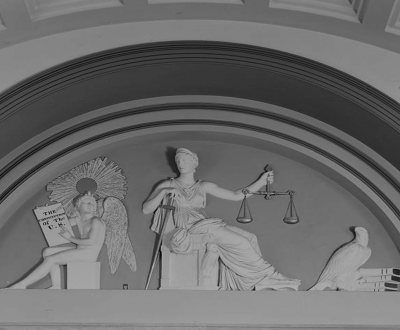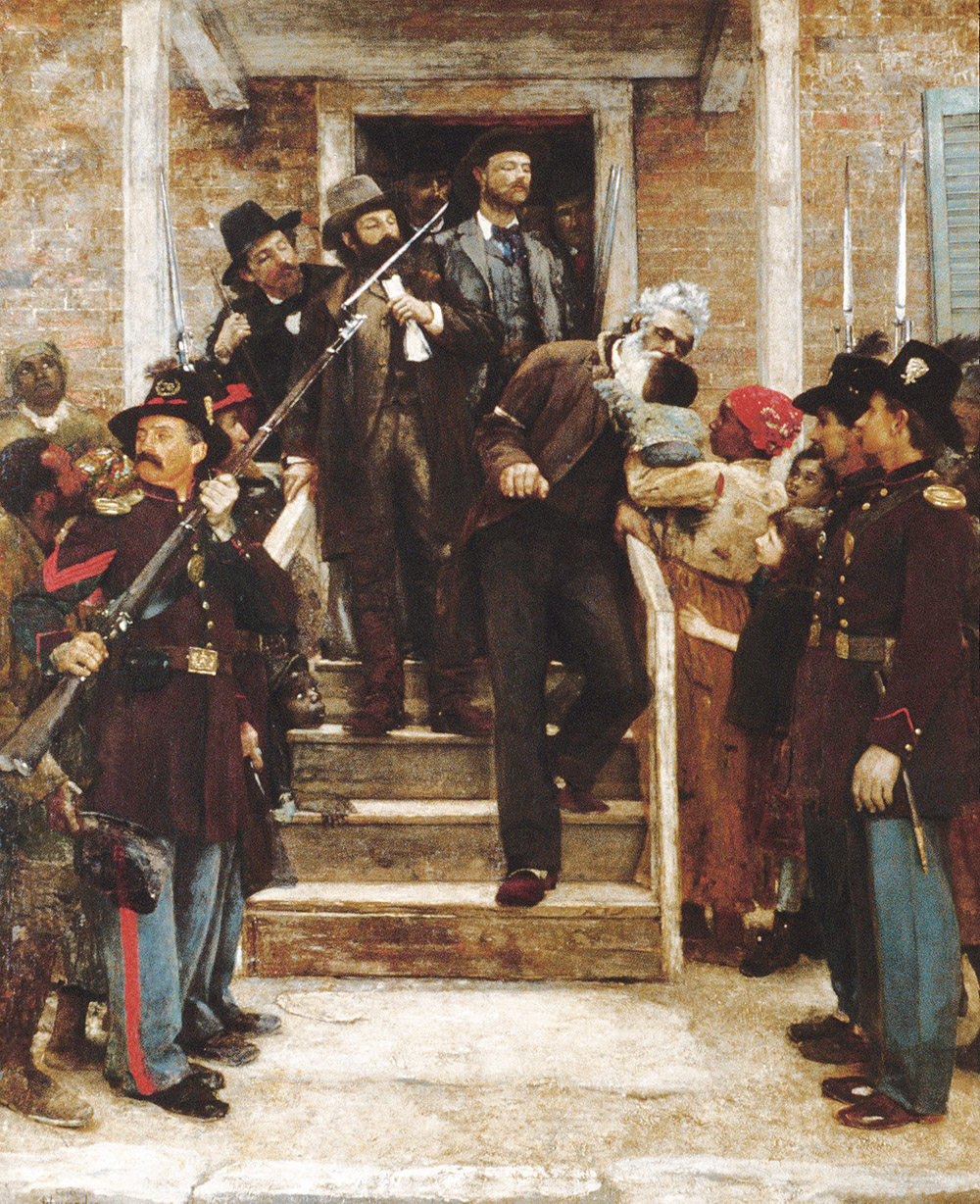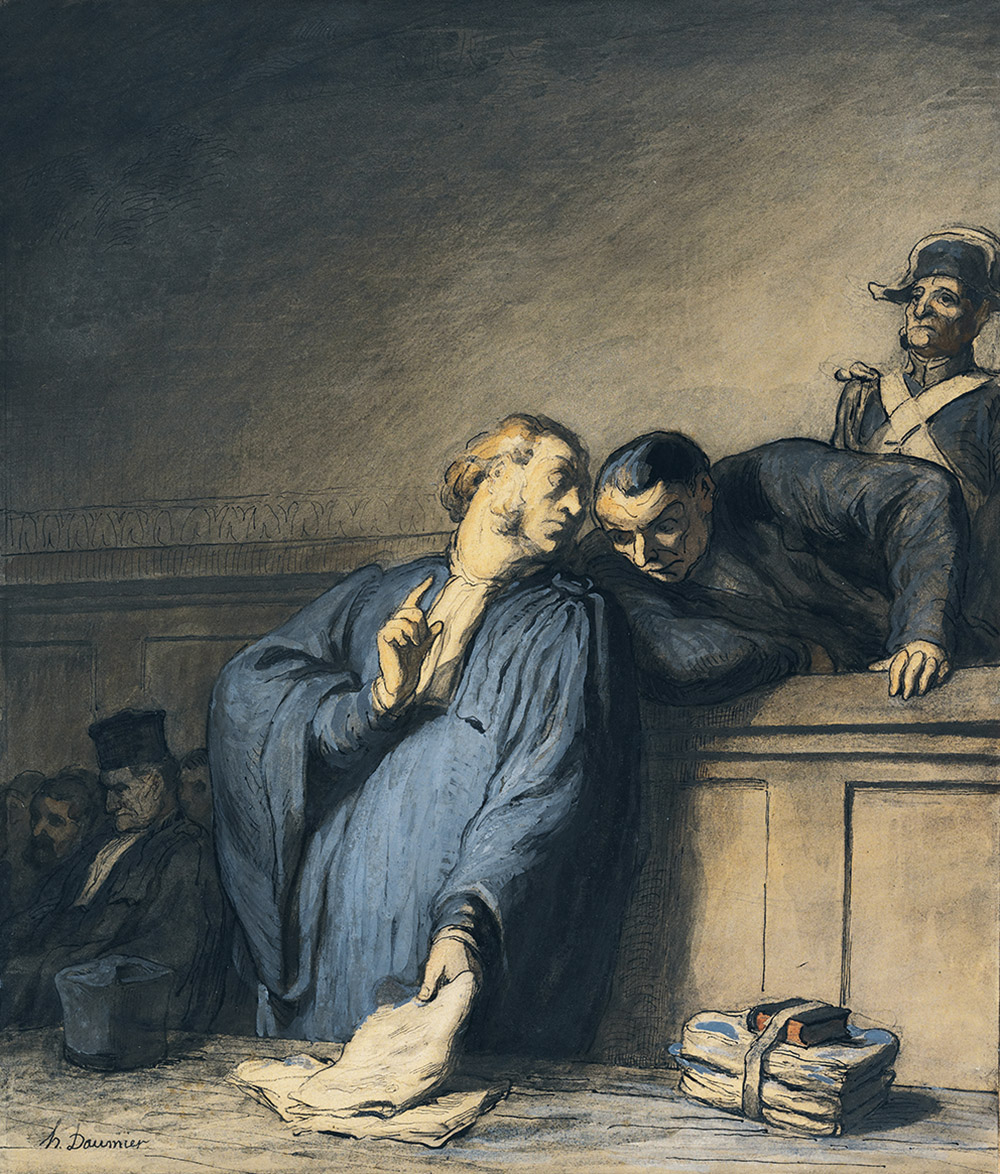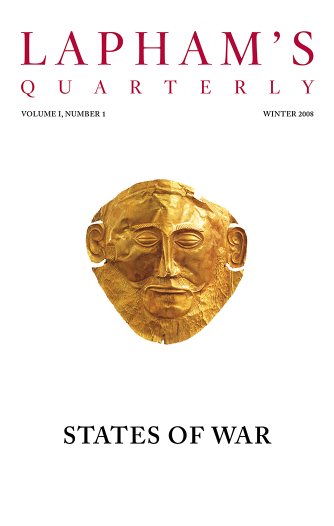If we do not maintain justice, justice will not maintain us.
—Francis Bacon, 1615Land of the Lawless
How power in America has turned the rule of law into a mere myth.
By Ralph Nader

Audio brought to you by Curio, a Lapham’s Quarterly partner
In the late 1970s, I had lunch with the head of the Internal Revenue Service. I broached a subject long on my mind: “I have been told that the section on insurance in the tax code is so complex that fewer people understand it than understand Einstein’s theory of relativity.” He replied that he wouldn’t doubt if that were true. So I followed up and asked, “How can it be enforced?” His answer was that it largely wasn’t.
If this seems shocking, beware—lawlessness is an overwhelming fact of American life, though little attention is paid to this many-unsplendored phenomenon. How many times have we been told that our country is under the rule of law and that nobody is above it? Yet the country’s legal life is defined instead by major zones of lawlessness created, in one aspect, by noncompliance and lack of enforcement and, in another, by raw power, which can be political, economic, or armed. These multiplying zones have pushed the rule of law into little more than a torrent of dysfunctional myths.
You might think attending one of America’s 205 accredited law schools would help a person see through all this. But with few exceptions, law schools teach the rule of law as if it were the norm—as if public condemnations of criminal acts and sometimes prosecuted violations mean our culture really is defined by its laws. Courses push students to hone their analytic skills to find conflicts, inconsistencies, distinctions, ambiguities, and textual improvements in the formal legal system. Rarely is the rule of law exposed for what it is, though from time to time schools of legal thought do examine this—as did the “legal realists” at Yale Law School from the 1920s to the 1950s or the “critical legal studies” professors from the 1970s through the 1990s. But the language of these schools was too abstruse. The scholars did not focus enough on reaching outside their academic groves and were mostly unable to foster any kind of social justice movement that could make the law mean what it should—that is, justice.
Over the past century, as laws have become more remote from public education and distant from popular access, they have also become more complex and more pervasive. In parallel, the various zones of lawlessness have expanded and the rule of power has increased. Occasional high-profile prosecutions or sanctions have helped promulgate the idea that laws are effective in their coverage, but such prosecutions have often been ineffective, with corporations demanding that Congress eliminate criminal penalties for willful and knowing violation of the law. To give just one example, corporate lobbyists succeeded in eliminating the criminal penalty from the 1966 automobile-safety laws, even when people were killed due to knowing violations of the government’s motor-vehicle safety regulations.
To see through a myth as pervasive as our rule of law requires a journey through these zones of lawlessness. Taking it may provoke the constructive outrage that can come from an informed sense of injustice.
Let’s start with systematic violations of the law that escape enforcement year after year. First, the health care industry, in which at least 10 percent of what our country spends goes down the drain from computerized billing fraud and abuse. According to Harvard professor Malcolm Sparrow, author of License to Steal, this 10 percent figure represents the minimum amount. Applying it to this year would produce a fraud amount of about $350 billion. The fraud is rarely prosecuted. In 1992 the Government Accountability Office estimated a comparable 10 percent drain, but Congress continued to starve the enforcement budgets of the Department of Health and Human Services and the Department of Justice. These agencies recover less than $3 billion of what’s defrauded from Medicaid, Medicare, and Tricare military insurance each year—appallingly low, given that commercial crooks defraud an estimated $60 billion from Medicare alone.

A Cauldron of Stars at the Galaxy Center, infrared image of the center of the Milky Way taken by NASA’s Spitzer Space Telescope, 2006. © NASA / JPL-Caltech / S. Stolovy (Spitzer Science Center / Caltech).
Even more alarming is what we learn from a May 2016 report from the Johns Hopkins School of Medicine estimating that there are a minimum of 250,000 lives lost yearly due to preventable problems in our nation’s hospitals. That’s an average of 5,000 deaths a week. These deaths stem largely from continual negligence—which can include accidents, misdiagnoses, malpractice, and hospital-induced infections—but criminal negligence and outright profit-driven criminality are also prevalent. Though these mass violations are supposed to be actionable by public prosecution and by private civil action under our tort laws, far less than 5 percent of potential civil cases are brought to attorneys by next of kin. Prosecutions are much rarer.
Also deeply underreported are the crimes that take place in the lawless zone of wage theft. A recent report by the Economic Policy Institute—which draws on surveys of state labor departments and attorneys general as well as data from the Department of Labor and class-action settlements—estimates $50 billion a year is stolen from mostly low-income workers, while terribly weak enforcement budgets and priorities led to the recovery of only some $2 billion in 2015 and 2016 combined.
The EPI examines wage theft through minimum-wage violations, overtime violations, tipping violations, and employee misclassifications. On average, it finds that workers suffering minimum-wage violations are cheated out of $64 a week, or $3,300 annually—all while the federal minimum wage has been frozen at $7.25 an hour. Such theft is clearly illegal. But in 2016, the EPI reports, the Department of Labor’s Wage and Hour Division had only a thousand investigators responsible for 7.3 million workplaces. And workers rarely file private claims anyway, as they are often forced to sign away their right to go to court in order to have a job in the first place.
All moanday, tearsday, wailsday, thumpsday, frightday, shatterday till the fear of the Law.
—James Joyce, 1939This is contract peonage, quite simply. But aside from the rare case of stolen-wage restitution, employers are almost never prosecuted under criminal laws. The absence of civil and criminal deterrence assures that big-time wage theft is part of the American worker’s nightmare.
Corporations further assert their power over the rule of law through tax evasion and avoidance. As Congress cut the IRS budget over the past decade (with inflation adjusted, down more than 25 percent from 2009), the agency has been increasingly unable to enforce the law against what it says is $400 billion a year in “uncollected taxes”—a sum that does not even include huge “avoided taxes” that flow from corporate lobbyists driving their agendas through a greased Congress. The result of this, says Robert McIntyre, who was the director of Citizens for Tax Justice for many years, is that citizen taxpayers have to pay more taxes and receive fewer public services or else incur larger government deficits.
Ongoing myths about the law serve to camouflage or protect these truly dominant acts of power—that’s an important reason for the near nonexistence of regular compliance reports by regulatory agencies to Congress and the public. Such reports would not only show widespread noncompliance and minimal enforcement, they would also reveal just how little help the aggrieved classes receive from legal processes. And, of course, indentured enforcement agencies do not have much interest in publicizing widespread violations of such magnitude. Doing so might generate an appropriate level of outrage—which could spur a movement to change the system that powerful institutions are more interested in keeping the way it is.
Why would government want to help diminish these zones of lawlessness? It, too, operates in one. Our uncontrollable national-security government has given us secret wars, secret law, secret courts, secret evidence, secret prisons, unauthorized secret budgets, unlawful surveillance of attorney-client communications, blatant snooping on all Americans, unauditable secret expenditures for quagmires abroad, and even redacted published judicial decisions. Though due process of law is arguably the greatest legal achievement of Western civilization, unlawful imprisonment (now euphemistically called “detention,” regardless of duration) of domestic persons and aliens are the stuff of media exposés that mostly go nowhere. Our government has too often shunted aside probable cause and upended habeas corpus and other bulwarks of due process. And U.S. courts contribute to the impunity through knee-jerk procedures blocking lawsuit challenges due to presumed “lack of standing” or by saying that a dispute is “political” and can only be resolved between the executive and legislative branches.
All moanday, tearsday, wailsday, thumpsday, frightday, shatterday till the fear of the Law.
—James Joyce, 1939Then, when legal bodies do attempt to speak out against this lawlessness, they are ignored. In 2005 and 2006, the normally reticent and conservative American Bar Association (under its president Michael Greco) sent three unprecedented white papers to President George W. Bush asserting that he was in violation of the Constitution. Neither Bush nor Vice President Dick Cheney ever bothered to acknowledge, much less respond to, these charges from the largest bar association in the world.
The government continued its extensive violations of our constitutional freedoms. In January 2012, an extraordinary article was published in the Washington Post by George Washington University professor Jonathan Turley outlining ten of them, which flowed from the official misuses of laws as well as from the instruments of oppression themselves, including all-too-routine prosecutorial abuses and lawlessness among police and in prisons. New York governor Andrew Cuomo’s 2018 State of the State address picked up on a similar theme, giving a shocking statistic: 75 percent of all inmates languishing in New York City jails have not been convicted of a crime but are simply awaiting trial. (Although not the subject of this essay, the lawlessness of the powerful—through their actions or inactions—have often worked to worsen the incidence of street and domestic violence.)
The view is no better on the international stage, where law cannot keep up with the violent insults of noncompliance with constitutions, treaties, or statutory restraints—from the general precepts of the laws of war to specific provisions of the Geneva Conventions. National sovereignties are routinely overridden by undeclared wars of choice, drone killings, illegal armed incursions, torture, and the widening license accorded military contractors. Greenhouse gases originate in one nation but traverse the globe, leading to devastating impacts. All are outside of any legal frameworks.

The Last Moments of John Brown, by Thomas Hovenden, c. 1884. The Metropolitan Museum of Art, Gift of Mr. and Mrs. Carl Stoeckel, 1897.
The maturation of the so-called corporate state has made all this even more entrenched. A major factor is military contracting. In September 2007 the government-contracted Blackwater Corporation used weaponized vehicles to slaughter fourteen unarmed Iraqis in one of Baghdad’s public squares. This briefly occasioned some attention from Congress, but by the end of October, Secretary of State Condoleezza Rice had officially informed the House Oversight Committee that—remarkably—there was no law covering the actions of Blackwater and their private police in Iraq. It seems that any crimes committed by corporations commissioned by the Defense and State Departments to perform guard duty and other classified tasks fell into a gap between Iraqi law—from which they were exempted by the U.S. military occupation—and the laws of the U.S. military itself. The rights of the individual guards were less clear; though some have been prosecuted, a single conviction for first-degree murder was overturned in circuit court in 2017.
Such lawless zones only become more complicated as technology advances. The daily evidence of international cyberwarfare and hacking—as well as corporate espionage—occurs without any framework of international law. There is presently no serious effort by the community of nations to negotiate international treaties regarding this volcanic, intrusive technology that, apart from stealing personal and official records, can destroy the critical infrastructure of societies.
Recourse does—or should—exist. America inherited from medieval England two great liberation movements for private action against wrongdoers: the law of contract and the law of torts. These two pillars of our private law are meant to empower wrongfully injured or defrauded people against wrongdoers by giving them their day in court with a trial by jury.
Do what thou wilt shall be the whole of the law.
—Aleister Crowley, 1904But here, too, powerful forces have fomented a culture of lawlessness. Corporate power has been able to erode the strength of these remedies by imposing one-sided fine-print contracts and by lobbying legislatures to seriously weaken the content and use of tort law. Though the latter is euphemistically called “tort reform,” it is a reform for corporations, not people. Corporate lobbyists have succeeded in having legislation enacted that arbitrarily ties the hands of judges and juries, who are the only ones who see, hear, and evaluate the evidence in each case in court. These lobbyists seek nothing less than impunity and immunity for their corporate entities.
Prominent lawyers, too, have been involved in weakening these remedies. Their unprofessional conduct flows from their status as so-called officers of the court, whose ethical responsibilities should be pointing them instead toward widening access to justice and its judicial institutions. But corporate law firms are the brains behind the political and economic domination of corporatism and its corporate state, which runs roughshod over weakening labor unions and consumer-defense organizations. They systematically obstruct use of the law by the very people meant to be protected by it.
One pervasive way this affects consumers is in debit- or credit-based cell-phone payment plans—an intricate system of consumer incarceration in which cell-phone users surrender access and privacy and become beholden to fine-print contractual servitude. Any attempts to fight back mean one is confronted with a series of difficult tasks, including reaching a human being working for the vendors. Consumers then have to deal with low bargaining power, nonexistent alternative competition, and the potential arbitrary actions of lowered credit ratings and credit scores. The judiciary usually protects vendors by invoking the myth of consumer consent while precluding practical remedies by the aggrieved. Computerized transactions between consumers and financial vendors have turned unconscionable penalties and fees into corporate profit centers worth tens of billions of dollars a year, especially against the poor, who are forced into these difficult, rigged arrangements and so pay more.

A Criminal Case, by Honoré Daumier, 1865. The J. Paul Getty Museum, Los Angeles. Digital image courtesy of the Getty’s Open Content Program.
This sort of thing is happening everywhere. Fast-expanding zones of lawlessness emerge from all kinds of rapid changes occurring in societies, from new technologies to new forms of capital to more complex inter-relationships between people and artificial entities like corporations. With government contracts there are the entrenched, complex, often secret abuses by corporate vendors, especially in the military and corporate welfare arenas. These official exercises of power without legal authority are bipartisan under both major political parties.
Law does not keep up, and the modern denizens of lawless territory like it that way. Just ask Wall Streeters, whose economic power allows them to deal in tax havens, complex commercial partnerships, and speculative derivatives that few humans can even understand, much less regulate. Where were the legal boundaries breached by the Federal Reserve, the U.S. Treasury, and the White House during the massive bailout of Wall Street and other companies? George W. Bush’s secretary of the Treasury, former chief of Goldman Sachs Henry Paulson, openly told the Washington Post that he “didn’t have the authorities for anything,” but “someone has to pull it all together.”
Avoid the law—the first loss is generally the least.
—Hannah Farnham Sawyer Lee, 1844It would be nice to believe such actions were aberrations from the rule of law. But they’re not; lawlessness in its many exercised forms of raw power is itself the norm. What it has wrought is the institutionalization of criminality—with overworld and underworld often blurring together—producing inequality of wealth and income, planting the seeds of political seizures by dictatorial, plutocratic, and oligarchic forces.
What can be done? We start with the lawyers, who are not only invested with the monopolistic right to be attorneys for clients but should also be obliged, as officers of the court subject to their code of professional ethics, to be the sentinels for the administration of justice. Some are heroically assuming this august obligation to the people. But far too few of the 1.3 million lawyers in America see the rule of law for the myth it is; too few see the rule of power for the lawlessness it creates. More of them must assume the higher significance of their calling, to respond to the silent cries for justice—which nearly two centuries ago Senator Daniel Webster called “the great interest of man on Earth” and “the ligament which holds civilized beings and civilized nations together.”


